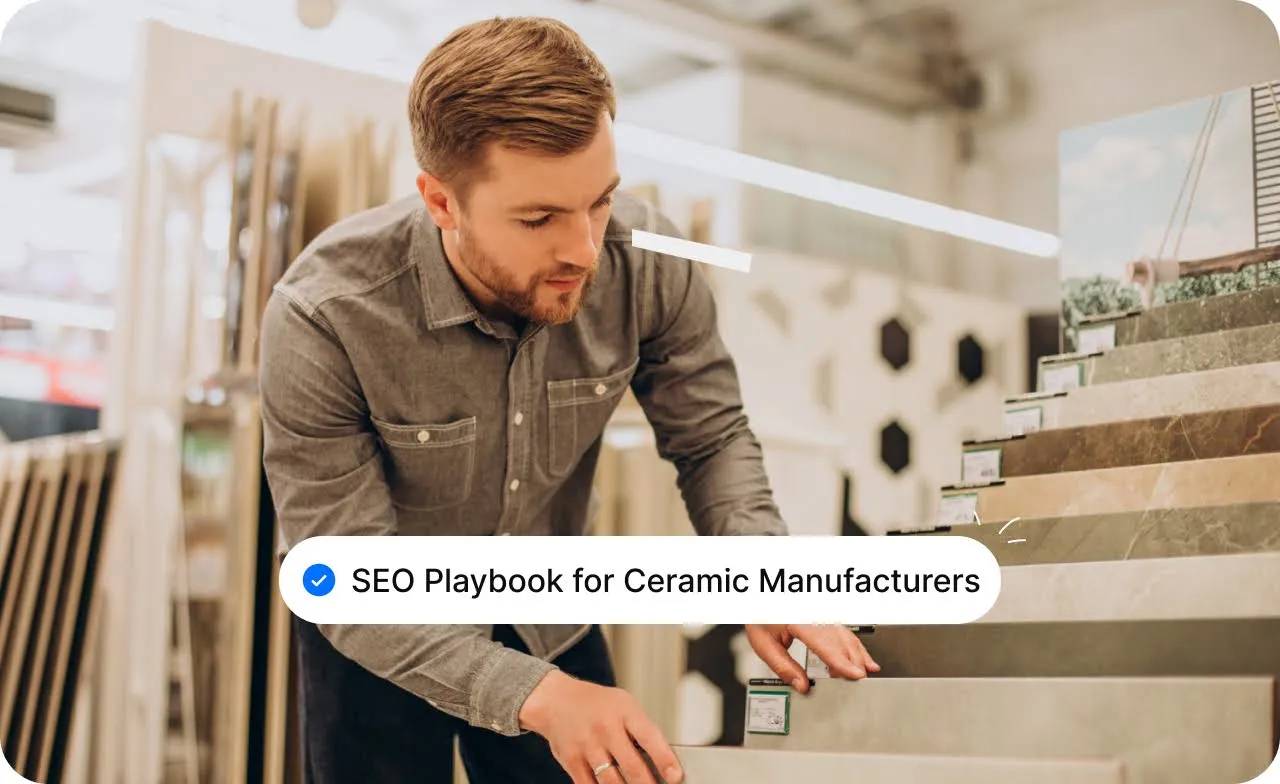Most ceramic manufacturers have a similar problem. You rely on trade shows, dealer networks, or word-of-mouth to drive sales, while their online presence barely brings in serious buyers.
A lot of the ceramic industry marketing focuses only on product categories. It rarely explains the things that matter during real purchase decisions: compliance, durability, order capacity, and delivery timelines. As a result, the buyers who need those details the most never reach your business.
The real goal of SEO is to help the right people find you and see why your products fit their needs.
This guide is for manufacturers tired of attracting generic traffic and ready to focus on SEO strategies that attract buyers who understand your products and are ready to engage.
How Buyers Actually Search for You?
Buyers don’t start their search with brand names. They start with what they need right now.
Here are a few real examples of how they search:
- An architect types “anti-slip ceramic tiles for commercial kitchens”.
- A dealer searches “vitrified tiles 600x1200 matte finish supplier”.
- A contractor might look for “ISO-certified ceramic tile manufacturers in Detroit”.
Each of these is what SEO professionals call a long-tail keyword. It’s a detailed phrase that shows clear buying intent. When your website content includes those phrases, naturally, inside product descriptions, headings, and meta titles, Google can connect your business to those exact searches.
How Manufacturers Go Wrong here?
They use broad terms like “high-quality tiles” or “leading ceramic manufacturer.” Those don’t match how real buyers search, so the right people never find them.
Put the same words your buyers use on your website. Once your pages reflect the way they search, the right people can finally find you instead of landing on competitors with weaker capability but better clarity.
Gushwork can map the exact terms your buyers search for and build your SEO around them, so your website starts bringing in the right enquiries.
1. Structure the Site with Keyword Groups and Page Structure
Effective site architecture for ceramic manufacturers revolves around structuring your content in a way that mirrors both your product offerings and how buyers search for them. Here’s how you can break down your pages:
- Material Hubs: These act as category pages for your core ceramic products. You could group products by their material type, such as porcelain, quarry, sanitary ware, and technical ceramics.
These hubs are essential for ranking in broader search queries and making your product categories more accessible.
- Finish / Size / Application Pages: These pages are optimized for specific customer needs, such as slip-resistant R11 tiles, matte finish bathroom ceramics, or 12x24 porcelain floor tiles.
These pages will help capture high-intent searches for customers looking for very specific product attributes.
- Spec Sheets & Compliance Pages: Regulatory compliance is a huge factor in the ceramic industry. Pages dedicated to ANSI, ASTM, ISO, and BIS certifications improve SEO and build credibility and trust.
- Dealer, Distributor, and Regional Market Pages: Create dedicated pages for dealers and distributors based on region, as this helps in local SEO and helps you serve B2B buyers more effectively.
Additionally, these pages can highlight key partnerships, driving local trust and expanding your market reach.
- Case Studies & Learning Resources: Case studies can showcase your ceramic products in real-world applications, enhancing trust and conversion rates.
Educational content like how-to guides, maintenance instructions, or tips for architects and designers can also drive organic traffic and engage your audience.
2. How to Organize Your Site for Growth?
A website built for scalability, crawlability, and speed is key for ceramic manufacturers with large product catalogs. Here's what you need:
- Flat, Crawlable URLs: Make sure your product pages are easy for search engines to find. Flat URLs like /ceramic-tiles/12x24-matte-porcelain are preferred over deeply nested directories.
- Smart Canonicals: Prevent duplicate content issues, especially for products that come in multiple sizes or finishes. Canonical tags ensure Google knows which page to index and show in search results.
- Index-Worthy Product Categories: Keep your product categories clean, logical, and user-friendly. Use structured categories that mirror your buyer's journey, this ensures your site scales easily as you add more products.
3. Build Strong Product and Collection Pages
To turn your product pages into lead-generating machines, use schema-driven templates for every collection and product series.
These templates ensure your pages are both user- and search engine-friendly.
Key Elements to Include:
- Schema Markup: Implement JSON-LD for Product, Offer, and AggregateRating to improve visibility in search results and enhance rich snippets.
- Specs & Certificates: Provide clear product specifications (size, material, compliance) and downloadable test certificates and installation guides.
- BIM/CAD Files: Offer BIM and CAD files for architects and designers to integrate your products into their projects.
- Alt-Tagged Galleries: Ensure your images are alt-tagged with keywords for better ranking in image search.

4. Make Your Catalogs and PDFs Search-Friendly
To optimize your ceramic product catalog and PDFs for search engines, focus on crawlability, load speed, and metadata:
Separate XML Sitemaps
Use separate XML sitemaps for products and resources (e.g., PDFs) to ensure search engines prioritize key product pages and properly index resources without slowing down your site’s crawl efficiency.
Text-Based PDFs with Canonical Links
Ensure text-based PDFs (not image-based) for better crawling. Include canonical HTML links in PDFs to link back to the main product pages, avoiding duplicate content issues and enhancing SEO.
CDN Optimization for Global Reach
Utilize a Content Delivery Network (CDN) to improve site speed and ensure quick access to product images and PDFs, regardless of where your customers are located. This helps provide a smoother experience globally.
By focusing on these key technical aspects, you improve the performance and SEO of your product catalog and resources, making them easier to find and faster to access for both users and search engines.
5. How Better Visuals Help You Win Specs?
Optimizing visual content is key to boosting both user engagement and SEO performance in the ceramic industry. High-quality visuals help users and search engines understand your products better, driving conversions.
Descriptive Image Names
Use keyword-rich filenames for your images, such as “porcelain-tile-12x24-matte-gray.jpg”, to help search engines index them properly.
This simple step improves your chances of ranking in image search results and enhances your overall SEO.
Room Visualizer for Kitchen and Bath Applications
Add a room visualizer tool that allows users to see your tiles in real-life settings like kitchens or bathrooms. This increases engagement and attracts long-tail traffic from search queries like “bathroom tile visualizer.”
AR Previews for Designers
Provide AR previews that let designers visualize your tiles in their own projects. This immersive experience boosts confidence in your products and helps designers make faster decisions.
With these strategies, you can optimize your visuals for both search engines and your target audience, improving both rankings and conversions.
6. Create Content Buyers Save and Revisit
Attracting architects and designers requires content that goes beyond product descriptions. Your content should serve as a resource that they rely on for accurate, technical, and practical information.
Here's how to craft content that keeps them coming back:
- Technical Explainers: Provide detailed content on R-ratings, DCOF, and EN/ISO standards. These technical details are essential for architects when selecting tiles that meet safety, durability, and regulatory standards.
This will help you rank for compliance-related search terms and position your brand as a trusted resource.
- Application Guides: Create guides for using your products in commercial and industrial spaces (e.g., hospitals, shopping malls).
These guides show real-world applications and help architects envision your products in their designs.
- Case Studies with Spec Sheets and BOQs: Share detailed case studies of completed projects with spec sheets and BOQs (Bills of Quantities).
This builds trust and provides architects with the technical details they need to specify your products in their projects.
- White Papers for Industrial Ceramics and OEM Buyers: Produce white papers focusing on the industrial ceramic market or OEM buyers. These documents provide deep insights into industry trends, helping position your brand as an authority.
7. How to Improve Visibility for Your Locations?
For ceramic manufacturers with showrooms or distribution centers, Local SEO is essential to increase visibility and attract local customers. Here’s how to optimize your Google Business Profile (GBP) and maintain a strong local presence:
1. Optimize Google Business Profile (GBP) for Each Location
Each showroom or distribution center should have its own Google Business Profile for local search and Google Maps visibility. Ensure:
- Accurate NAP (name, address, phone)
- Relevant business categories (e.g., "Ceramic Tile Supplier")
- Updated business hours and product listings
2. Maintain Consistent NAP Across Listings
Ensure your NAP details are consistent across all platforms (website, social media, directories). Inconsistencies can harm your local SEO rankings.
3. Add Photos, Q&A, and Product Posts
- Upload high-quality photos of your showroom and products.
- Engage with customers through the Q&A section.
- Regularly update your product posts to showcase offers and new arrivals.
8. List Your Products on Important Marketplaces
Expanding your reach beyond your website to key industry marketplaces and directories is a smart way to attract more B2B leads and increase visibility.
These platforms, like ThomasNet, Build.com, and Houzz Pro, provide a powerful avenue to connect with potential buyers who may not discover your products on your website alone.
Here’s how to optimize your presence across these platforms:
Optimize Listings on Major Directories
Each listing on B2B directories should be thoroughly optimized:
- Ensure your product titles, images, and specifications are aligned with your website’s product pages. Consistency between your listings and your main site improves brand recognition and search rankings across multiple platforms.
- Include detailed descriptions, features, and product specs to provide a complete picture of what you offer. Buyers are more likely to trust listings with full information.
Maintain Consistent Product Information
Consistency is key when syndicating across directories:
- Use identical product names and dimensions (e.g., “12x24 Porcelain Floor Tile – R11 Slip-Resistant”) across all platforms. This avoids confusion and helps reinforce your product identity across multiple touchpoints, making it easier for customers to find you.
- Avoid variations in your product descriptions to prevent duplicate content issues, which could negatively impact your SEO rankings.
Track Referral Traffic & Quote Requests
Don’t just list your products; measure how well your directory listings are performing:
- Track referral traffic from each directory to understand which platforms are sending the most visitors to your website.
- Monitor quote requests and lead generation activity to see which directory listings are converting the best. This helps you focus your efforts on the most effective platforms and continuously refine your strategy.

9. Earning Trusted Mentions for Your Brand
Building authority through link earning is a powerful strategy for improving your SEO and driving qualified traffic to your site. Here’s how to do it effectively:
Features in Architecture & Design Magazines
Being featured in top design magazines or industry publications (like Architectural Digest) helps earn valuable backlinks that increase credibility and visibility among architects and designers.
Partnerships with U.S. Tile Associations
Collaborate with associations like the CTDA, NTCA, or TCNA. These partnerships offer high-quality backlinks, boost brand recognition, and connect you with a broader audience of industry professionals.
Supplier Collaborations & Case Studies
Showcase successful projects where your products are used. Collaborate with contractors and suppliers to publish case studies with spec sheets and BOQs, ensuring that they link back to your site.
10. What to Track to Understand Your Results
Track the metrics that matter most to optimize your growth:
- Leads & Sample Orders: Track qualified leads and sample orders to measure conversion intent and sales funnel performance.
- Spec Downloads & Dealer Sign-Ups: Monitor spec sheet downloads and dealer sign-ups to gauge interest and expand your distribution network.
- Organic Traffic from Architects & B2B Buyers: Analyze organic traffic from high-value decision-makers like architects and B2B buyers to assess your SEO strategy’s effectiveness.
- Keyword Visibility for Compliance & Product Terms: Track keyword rankings for niche terms like ANSI compliance and R11 slip resistance to gauge authority and trust.
Your First 90 Days of Action
A well-structured plan is key to turning your SEO and link-building efforts into real growth.
Here’s a breakdown of a 90-day execution plan to ensure your efforts are aligned, effective, and measurable:
- Weeks 1-3:
- Audit your site crawl/index to ensure technical SEO is set up for success.
- Define keyword clusters for each product category and location.
- Fix any template or content gaps on your product pages to ensure they’re ready for SEO and link-building.
- Weeks 4-6:
- Add schema markup for each product page.
- Optimize images for SEO and improve Google Business Profiles (GBPs) for your dealers and showrooms.
- Begin publishing spec explainers and case studies showcasing successful projects using your ceramics.
- Weeks 7-9:
- Publish case studies, including BOQs and spec sheets, to strengthen your backlink profile.
- Focus on outreach for backlinks, connect with trade publications, suppliers, and associations for guest posts and mentions.
- Weeks 10-12:
- Optimize listings across marketplaces like ThomasNet and Houzz Pro.
- Begin link syndication on directories, ensuring your product specs, images, and titles are consistent across all platforms.
Turn Your SEO Into a Revenue Engine
A well-structured SEO strategy can elevate your ceramic manufacturing site from just a digital presence to a 24/7 lead-generating powerhouse.
By optimizing your site for architects, builders, and global dealers, you’ll ensure that they’re actively seeking your products when they're ready to buy.
- SEO is about converting that traffic into valuable leads.
- A targeted, data-driven approach is key to attracting the right decision-makers for your products.
- Optimizing for compliance, specifications, and visuals enhances your credibility and reach.
Struggling to keep your lead generation and SEO efforts running smoothly, without the necessary resources to scale efficiently?
FAQs
Q1. Why is SEO important for ceramic manufacturers?
A1. SEO helps ceramic manufacturers increase their online visibility, attract high-quality leads, and drive traffic to their website. By optimizing for relevant keywords, compliance standards, and product specifications, you ensure that potential customers find your products when they're actively searching.
Q2. How can keyword optimization improve my ceramic product pages?
A2. By optimizing your ceramic product pages with relevant keywords, you increase the likelihood of appearing in search results. Keywords like "porcelain tiles," "R11 slip-resistant," and "ISO compliant" help search engines identify your pages and rank them higher for the right audience.
Q3. What role do product images play in SEO for ceramic manufacturers?
A3. Optimized product images are essential for both user engagement and SEO. By using descriptive image names, ALT tags, and visual SEO tactics, you improve your chances of ranking in image search and creating a better user experience for potential buyers.
Q4. How do I optimize my Google Business Profile for showrooms and dealers?
A4. To optimize your Google Business Profile (GBP), ensure accurate NAP (Name, Address, Phone) information, upload high-quality photos, and maintain up-to-date product posts. Consistency across listings and engaging with customer reviews can boost local SEO, making it easier for nearby customers to find you.
Q5. What’s the benefit of using schema markup for product pages?
A5. Schema markup adds structured data to your product pages, helping search engines better understand your content. This can improve visibility in rich snippets, increasing your chances of standing out in search results, especially for detailed products like tiles with specific features or certifications.
Q6. How can case studies and project documentation improve my SEO?
A6. Case studies and project documentation offer valuable content that can drive targeted traffic. By including spec sheets and BOQs, you provide proof of your products' real-world applications, which helps with both SEO rankings and building trust with architects and contractors.
Q7. How do I track the success of my SEO efforts?
A7. Use tools like Google Analytics to track key metrics such as leads, sample orders, spec downloads, and dealer sign-ups. Monitoring organic traffic from high-value keywords and conversion rates helps you assess the effectiveness of your SEO strategy and make data-driven adjustments.




















.webp)








.webp)
.svg)


.svg)
.svg)
.svg)







.svg)